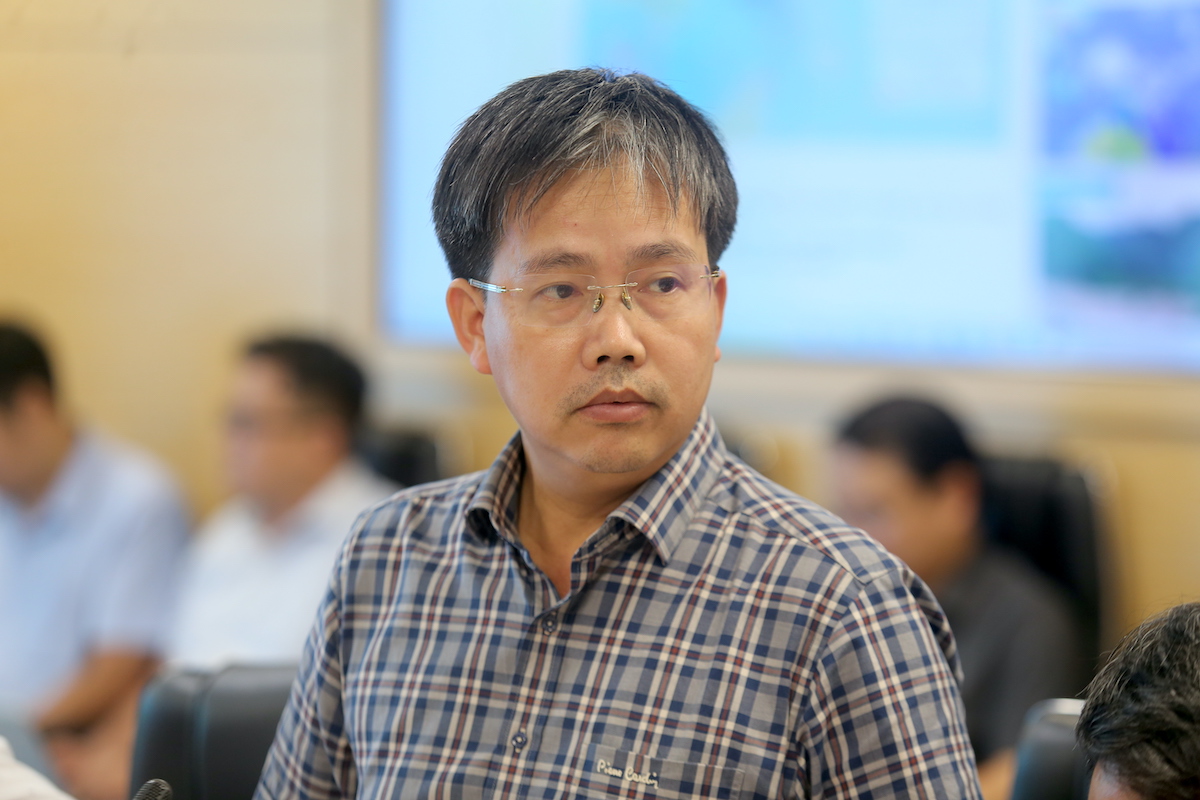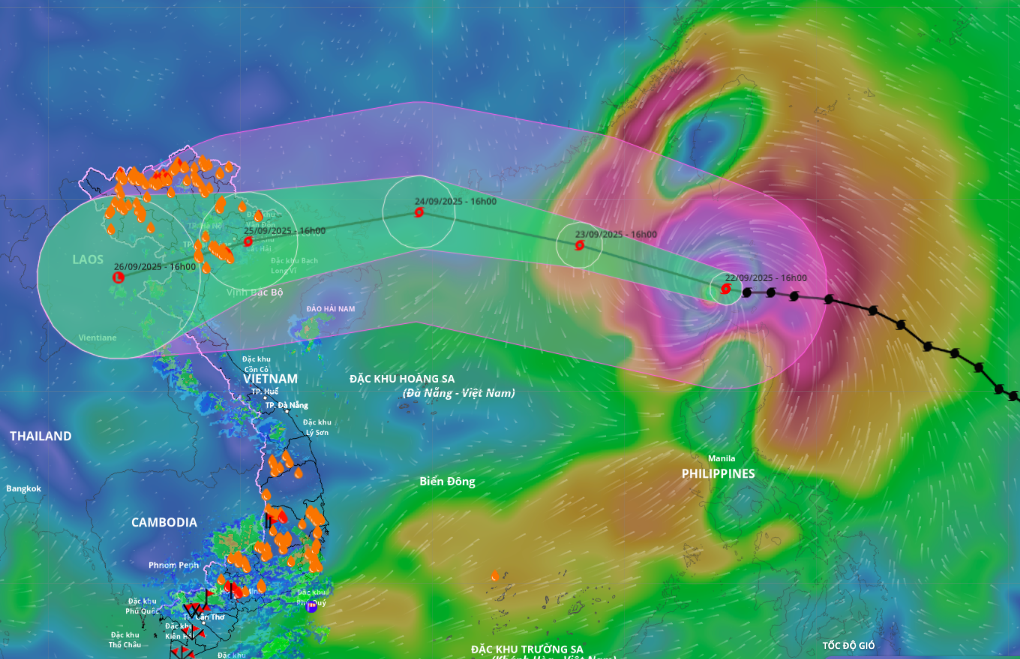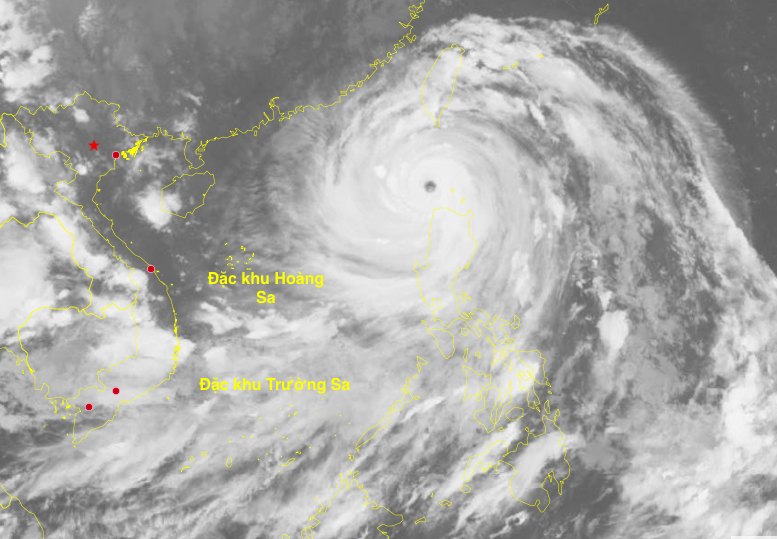On the afternoon of 22/9, the National Steering Committee for Natural Disaster Prevention and Control held a meeting to discuss super typhoon Kagasa. Mai Van Khiem, director of the National Center for Hydro-Meteorological Forecasting, reported that the typhoon had reached category 17, with gusts exceeding category 17, and was located approximately 120 km north of Luzon Island (Philippines). Around 10 PM the same day, the typhoon entered the South China Sea, becoming the 9th typhoon of the year. It was expected to maintain category 17 for the next six hours and remain a super typhoon at category 16-17 on 23/9.
Despite being assessed as stronger over the sea than typhoon Yagi in 2024, Khiem suggested that several factors would contribute to Kagasa's rapid weakening in the coming days. A continental high-pressure system with dry air and 30-40% humidity in the north was moving south.
"The entire northern part of the typhoon will be affected by this air mass. Dry swirls penetrating the typhoon's structure are a key factor in its weakening as it approaches the waters south of Guangdong province and Leizhou Island on 24/9," Khiem explained, emphasizing that this phenomenon contrasts with Yagi, where the northern and western circulation brought moist air.
 |
Mai Van Khiem gives his assessment at the meeting. Photo: Gia Chinh |
Unlike Yagi, which moved south of the subtropical high system, Kagasa is tracking west and is forecast to shift further north in the next two to three days, leading to friction with the Chinese mainland terrain. International forecasts and an AI model jointly tested by Vietnam and Japan agree on a trajectory north of Leizhou Island, rather than south like Yagi, indicating a more pronounced weakening.
Furthermore, statistics show that a typhoon's lifecycle is typically five to seven days, peaking on the third or 4th day. Kagasa formed on 18/9 and is currently at its peak intensity, expected to weaken gradually. As it crosses the Leizhou Peninsula and enters the Gulf of Tonkin, the typhoon is predicted to decrease to category 11-12, with gusts up to category 14. Wind speeds of category 9-10, with gusts up to category 14, are possible onshore from Quang Ninh to Thanh Hoa. Rainfall is expected to be 150-250 mm, with some areas in Thai Nguyen, southern Tuyen Quang, Lao Cai, Phu Tho, and the Red River Delta exceeding 450 mm; the Thanh Hoa - Ha Tinh region is expected to receive 70-150 mm.
"If the typhoon moves into Guangdong province and then deviates significantly northwards inland instead of following the coast, strong winds in the Gulf of Tonkin and onshore in Vietnam will be reduced," Khiem stated.
 |
Projected path and impact zone of super typhoon Kagasa. Photo: Disaster Monitoring System |
Early reservoir operation
Pham Duc Luan, director general of the Dyke Management and Disaster Mitigation Department, reported that reservoirs are currently in the final water storage phase of the dry season, leaving limited remaining capacity. The Son La reservoir is over 1 m below its normal water level, holding 761 million m3; the Tuyen Quang reservoir is 2.5 m below, holding 184 million m3; and the Thac Ba reservoir is 0.48 m below, holding 105 million m3.
Seven reservoirs in northern Vietnam and three in north-central Vietnam are currently releasing water through spillways at a rate of 30-50 m3/s. Deputy Minister of Agriculture and Rural Development Nguyen Hoang Hiep assessed the biggest risk as heavy rainfall combined with the safe operation of individual and interconnected reservoirs. According to the standard procedure, after 20/9, these reservoirs have entered the end of the main flood season.
"The Tuyen Quang reservoir fills up in just a few hours. The reservoirs are currently maintaining 80-90% capacity. With the current rain forecast, early operation of the interconnected reservoir system is necessary to avoid incidents like those at Thac Ba reservoir last year or Ban Ve reservoir this year," Hiep emphasized.
 |
Satellite image of super typhoon Kagasa at 7:15 PM on 22/9. Photo: Department of Meteorology and Hydrology |
At noon the same day, Deputy Prime Minister Tran Hong Ha signed a telegram urging ministries, sectors, and localities from Quang Ngai northward not to be complacent and to prepare for super typhoon Kagasa with utmost determination, taking proactive and early measures, anticipating the worst-case scenario to ensure the safety of residents.
The government also requested coastal provinces, especially from Quang Ninh to Thua Thien Hue, to postpone unnecessary meetings, mobilize the entire political system, and promptly inform vessels about the typhoon's development for proactive avoidance. Localities should base decisions on specific circumstances to restrict or prohibit maritime activities, while preparing personnel, equipment, and evacuation plans if needed.
Gia Chinh












